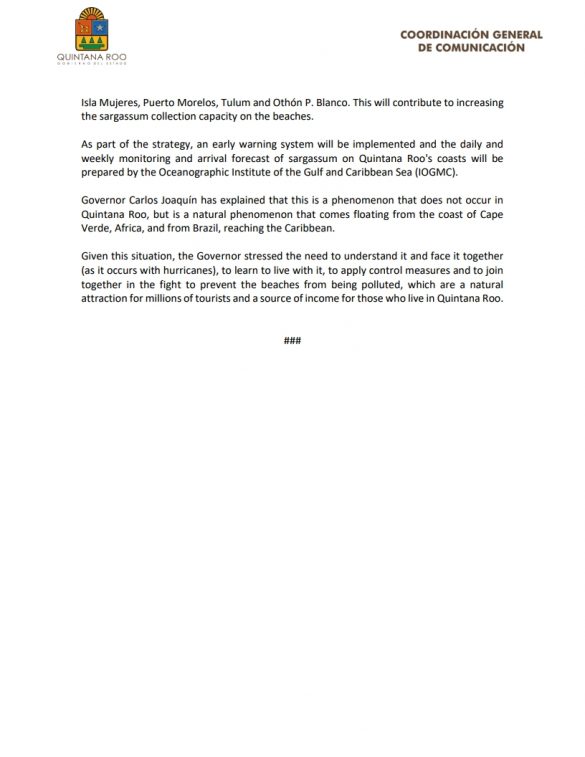Fact Sheet
April 11th, 2022
*The strategy includes sargassum containment in the sea with boats and barriers close to the beaches; citizens participate collecting in the sandy areas
Chetumal – Based on the strategy implemented and deployed by the National Strategy Coordination for Sargasso Attention in Quintana Roo, the arrival of seaweed to the state’s beaches is being dealt with in order to keep the beaches clean for as long as possible, depending on the weather conditions.
So far, a total of 97 anchorages and 500 meter-barriers have been installed in Mahahual, and 120 anchorages in Playa del Carmen, Solidaridad, where the installment of 2,700 linear meters of barriers to contain the sargassum will begin this Monday.
In addition, a collective effort is being made by civil society and the private sector to collect sargassum and clean beaches.
With the support of the Solidaridad local authority, more than 200 municipal public service workers have joined the Federal Maritime Terrestrial Zone (Zofemat) brigades in Playa del Carmen in the seaweed removal from the beaches.
Dump trucks and tractors were seen this morning working to keep the beaches free of sargassum.
3,300 tons of sargassum were collected from the Playa del Carmen beaches last weekend.
The installation of a 100 meter-barrier in Puerto Morelos has also begun. At this point, the rest of the barrier is also ready to be installed at the docks or nearby locations, waiting for better weather conditions to proceed.
The strategy to deal with sargassum includes the Ministry of Navy operation with boats and a sargassum vessel to remove the seaweed from the sea.
There are six coastal sargassum vessels in Mahahual ready for the most affected municipalities of the state; these vessels have already received maintenance at the Chetumal Repair Center Number 11 (CENREPCHET-11).
In addition, major maintenance has been carried out on four tractor vehicles with sweepers, which are scheduled for delivery during the second week of April in the municipalities of Isla Mujeres, Puerto Morelos, Tulum and Othón P. Blanco. This will contribute to increasing the sargassum collection capacity on the beaches.
As part of the strategy, an early warning system will be implemented and the daily and weekly monitoring and arrival forecast of sargassum on Quintana Roo’s coasts will be prepared by the Oceanographic Institute of the Gulf and Caribbean Sea (IOGMC).
Governor Carlos Joaquín has explained that this is a phenomenon that does not occur in Quintana Roo, but is a natural phenomenon that comes floating from the coast of Cape Verde, Africa, and from Brazil, reaching the Caribbean.
Given this situation, the Governor stressed the need to understand it and face it together (as it occurs with hurricanes), to learn to live with it, to apply control measures and to join together in the fight to prevent the beaches from being polluted, which are a natural attraction for millions of tourists and a source of income for those who live in Quintana Roo.

